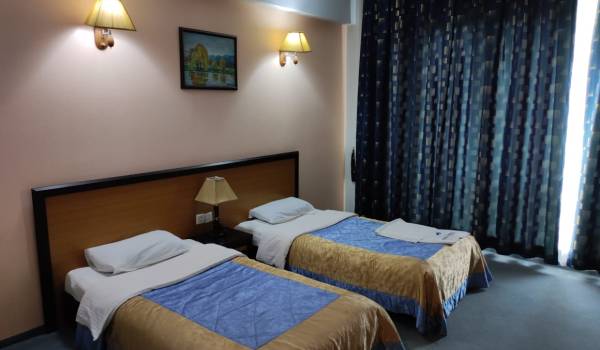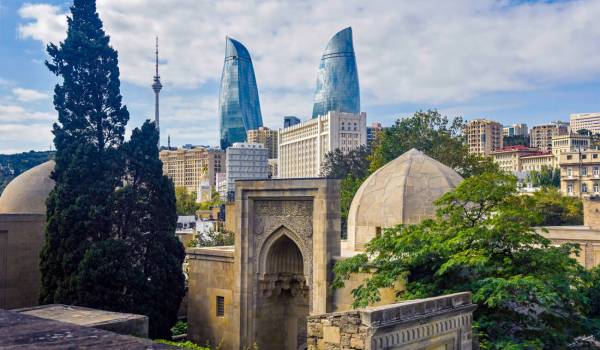Gazakh DESTINATION
Gazakh region is located in the western part of the republic, in the eastern part of the Ganja-Gazakh plain, starting from the slopes of the Little Caucasus mountain range and extending along the right bank of the Kura river.
The famous Goyazen Mountain, Avey Mountains, and the Damjili spring are located in the western part of the Ganja-Gazakh plain, on the banks of the Kura River. Mount Goyazen is the second most beautiful mountain in the world after Mon-Pele in the American continent. 20 km west of the center of Gazakh, the pure water springs of Farahli village, medicinal mineral water, and a large forest with a mountain-meadow landscape are considered to be affordable for recreational tourism. 17 km north of the district center, surrounded by Tugay forests and located on the banks of the Kura River Salahli village is suitable for fishing and poultry hunting.
The construction of both the balneological sanatorium and tourist accommodation in the territory of the village can lead to the development of medical and rural tourism.
The territory of Gazakh region is rich in ancient architectural monuments: Historical and cultural monuments of national importance including the Broken Bridge (xii), the temple in the village of Yukhari Askipara (V-Vlll), the Didvan Tower in the Khanliglar village (v-vii), the Albanian temple in the village of Dash Salahli.
Among the interesting places of interest in the region are the caves located on Mount Avey near the village of Dash Salahli. Archaeologists have unearthed ancient human settlements, tools, and weapons.
Gazakh is the homeland of a number of talented poets, scientists and hugs of Azerbaijan. Among the poets, Molla Panah Vagif, Molla Vali Vidadi, Samad Vurgun, writer Mehdi Hussein and others were born in this land.
In 2010, it was declared as "Gazakh - the capital of folklore of Azerbaijan." Gazakh is also one of the centers of carpet weaving. Many residents of the region still continue this traditional folk art. Gazakh carpets are included in the intangible heritage of the region.
Gazakh carpets - According to archeological materials and written sources, carpet weaving has been practiced in Azerbaijan since the Bronze Age (late 2nd millennium BC - early 1st millennium BC). The city of Gazakh and surrounding villages have been one of the centers of carpet weaving in Azerbaijan for centuries. Pile and non-pile carpets decorated with various pattern elements and images are widely used in Gazakh households.
Dilbaz horse (Gazakh horses) - a breed of horse bred in Azerbaijan in the late XVIII and early XIX centuries. It is the national (local) horse breed in the Republic of Azerbaijan and is one of the ancient ones. Dilbaz horse was created in the Gazakh district in the late 18th and early 19th centuries on the basis of crossbreeding local horses with Eastern horses and under the influence of the Karabakh breed.
Gazakh dance - one of the oldest Azerbaijani dances. As its name suggests, the dance originated in the Gazakh zone. It is assumed that Gazakh is a warrior dance. It was performed when marching and going to war. The dance is rich in subtlety and restraint, along with the pathos of optimism and heroism. Dance requires precise movements and greatness of inner strength. It has many versions and can be played on various instruments.
Gazakh ashugs are famous all over Azerbaijan. One of the highest peaks of Gazakh folklore is connected with the art of ashug. Gazakh is known as the homeland of Ashugs.
Avey State Reserve operates in the Gazakh region. The reserve was established in 1989. The reserve is mainly engaged in history, culture, architecture, ethnography, art, and other folklore. There are hundreds of historical and cultural monuments in the reserve. They are considered to be the main property of the reserve. Of these monuments, 15 are architectural, 36 are archeological and 5 are decorative applied arts.
The reserve researches and studies archeological and architectural monuments, and ethnographic materials of different ancient historical periods of the region.
Studies conducted by Japanese historians in the Damjili and Babadervish caves in the Gazakh region prove that there were human settlements in Gazakh 8,000 years ago.
The Arab historian Al-Kufi (ninth century) also referred to this place as "Kasak" (Kasaq) in connection with the events of the 7th century.
The cave camp is located under the limestone rock in the southeast of Aveydag, which stretches from the Dash Salahli village of Gazakh region to the Anakhatir river. Aveydag is the largest one of the group of caves. It is semicircular. The front part is destroyed. The height on the opposite side is 4 meters. It is called Damjili due to water droplets filtered through natural cracks.
There are 112 historical monuments of global, national, and local importance in the Gazakh district. 54 of them are archaeological, 46 are architectural, 7 are monumental-historical monuments, and 5 are decorative-applied fine art monuments.
There are 112 monuments in Kazakh. These are Damcili cave camp, (Paleolithic period), Albanian temple (6th century), Red bridge (12th century), etc.
Gazakh region is a region of Turkish origin.
Tourism-excursion routes of Gazakh region.
Tourism excursion routes are offered in four directions in the Gazakh region.
The 1st route is in the city of Gazakh. History Museum, Kazakh State Art Gallery, Memorial Museum of M.P. Vagif and M.V. Vidadi, Juma Mosque, (historical architectural monument), Israfilaga Bath (historical architectural monument), Seminary (historical monument), Thinkers' Park, Ismayil Shikhly's statue, January 20 Martyrs' Alley, a park for mothers and children to have fun, Heydar Park and Heydar Aliyev Science Center, memorial monuments to our compatriots who died in the Great Patriotic War, Olympic complex, Dede Gorgud monumental monument complex, Dilboz horse statue, Sports and Health complex.
The 2nd route is in the direction of the Red bridge. S. Vurgun's poetry house (monumental memorial, Yukhari Salahli), M.P. Vagif's statue erected in 1947 (Yukhari Salahli), Haji Mahmud Effendi's tomb (Aslanbeyli), Haji Mahmud Effendi's house and mosque (Aslanbeyli), M.V. Vidadi's tomb monument (Erinci Shykhly), home museum of Italian national hero Tahir Isayev (First Shykhly), Red Bridge (XII century historical architectural monument, Second Shykhly).
The 3rd route is in the direction of Gazakh - Agkoynek - Khanliq. Nohur - spring (Agkoynek), Velikhan forest, Aghstafa river reservoir (Jafarli), Kar rock, Didivan tower (historical architectural monument - VI-VII centuries), Bayram spring, Babadarvish settlement, Tomb architectural monument (XIX century), Ancient place of residence (archaeological monument - Middle Ages, Khanate).
The 4th route is in the direction of Gazakh - Dash Salahli - Abbasbeyli. Damcili spring, Natural monument, Damcili temple, Cave (archaeological monument - antiquity), Mammadkokha spring (archaeological monument, 6th - 5th centuries), Koroglu temple, Albanian temple (architectural monument, 6th - 5th centuries), Stone reservoir (archaeological monument - ancient period), Water pool (archaeological monument - ancient period, Stone Salahli), Cogaz lake, Residential settlement (archaeological monument - middle ages), Goyazan mountain, Goyazan castle (XIV century), Stone horse figure (Abbasbeyli).
Gazakh Accommodations
Browse through our carefully curated collection of hotels, resorts, and accommodations tailored to each destination. Whether you're seeking luxury, relaxation, or a budget-friendly option, our accommodation section offers a diverse range of choices to suit every traveler's needs. From charming boutique hotels to sprawling resorts, find your perfect home away from home and make the most of your stay in each destination.








